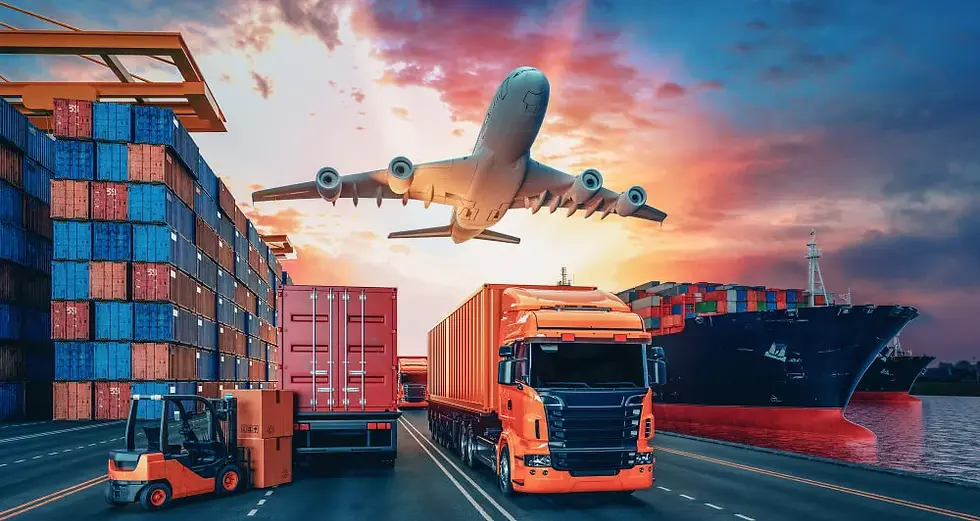The Port of Rotterdam: Europe's Gateway to Global Trade
- CNXtrans

- May 4, 2023
- 4 min read
The Port of Rotterdam is Europe's largest seaport and one of the world's busiest ports. Situated in the Netherlands, the port is strategically located at the mouth of the Rhine-Meuse-Scheldt delta, connecting the European hinterland with the rest of the world. With its state-of-the-art infrastructure, innovative solutions, and sustainable practices, the Port of Rotterdam is a crucial hub for global trade and a key player in the global logistics industry.
History of the Port of Rotterdam
The Port of Rotterdam has a rich history dating back to the Middle Ages. Initially, the port was a small trading post, but it rapidly grew in importance due to its strategic location on the River Maas. Over the centuries, the port underwent significant changes and expansions, especially in the 19th and 20th centuries, as it transformed into a modern and efficient seaport. Today, the Port of Rotterdam handles over 460 million tons of cargo per year, making it the largest port in Europe and the eighth largest in the world.
Infrastructure and Facilities
The Port of Rotterdam is a vast complex with a total area of over 12,500 hectares, including over 4,000 hectares of industrial sites and over 2,700 hectares of water. The port features state-of-the-art infrastructure and facilities, including over 80 terminals, 400 berths, and 1,000 cranes. It also has a comprehensive network of road, rail, and waterway connections, allowing for seamless transportation of goods to and from the port.
The port's facilities are designed to handle a wide range of cargo types, including containers, bulk cargo, liquid bulk, and breakbulk. It also has specialized terminals for handling commodities such as coal, iron ore, and oil, as well as facilities for the storage and handling of hazardous materials.
Sustainable Practices
The Port of Rotterdam is committed to sustainability and has implemented a range of measures to reduce its environmental impact. These include initiatives to reduce emissions, conserve energy, and promote the use of renewable energy sources. For example, the port has invested in wind power, solar power, and biomass to reduce its reliance on fossil fuels. It has also implemented measures to reduce noise pollution, improve air quality, and protect local ecosystems.
In addition, the port has a comprehensive waste management program, which includes recycling and the responsible disposal of hazardous waste. It also supports initiatives to promote sustainable transport, such as the use of electric vehicles and the development of cycling infrastructure.
Innovative Solutions
The Port of Rotterdam is a leader in innovation and has implemented a range of cutting-edge technologies to improve efficiency, safety, and security. For example, it has implemented a digital platform called PortXchange, which provides real-time information on vessel schedules, cargo flows, and berth availability. This platform allows for better coordination and communication between stakeholders, reducing waiting times and improving the overall efficiency of the port.
The port has also implemented a range of smart technologies, such as automated cranes, drones, and sensors, to improve safety and security. These technologies allow for faster and more accurate inspections, reducing the risk of accidents and increasing the security of the port.
Economic Impact
The Port of Rotterdam is a major contributor to the Dutch and European economies. It generates over €45 billion in added value and provides employment for over 385,000 people. The port is a key driver of innovation and technological development, and it plays a crucial role in facilitating global trade and promoting economic growth.
Future Developments
The Port of Rotterdam is constantly striving to enhance its facilities and services to remain at the forefront of the global logistics industry. To achieve this, the port has several ambitious projects in the pipeline.
One such project is the development of the Rotterdam World Gateway Terminal. This state-of-the-art terminal will have a handling capacity of 4 million TEU per year, making it one of the largest and most advanced container terminals in the world. The terminal will feature automated cranes, advanced IT systems, and sustainable energy solutions, ensuring efficient and eco-friendly operations.
Another significant project is the construction of the Container Exchange Route, a new railway line that will connect the port to the German hinterland. This project will increase the port's rail capacity, reduce road congestion, and promote sustainable transport.
The Port of Rotterdam is also investing in the development of digital technologies to enhance its operations and services. For example, it is working on the development of a blockchain-based platform to streamline supply chain processes and improve transparency and efficiency.
Furthermore, the Port of Rotterdam is committed to sustainability and has set ambitious targets to reduce its environmental impact. It aims to become a zero-emission port by 2050, and to achieve this, it is implementing a range of measures, such as the use of renewable energy sources and the promotion of sustainable transport.
Conclusion
The Port of Rotterdam is Europe's gateway to global trade, a key player in the global logistics industry, and a leader in innovation and sustainability. With its state-of-the-art infrastructure, comprehensive network of connections, and commitment to sustainable practices, the port is well-positioned to meet the challenges and opportunities of the future. As global trade continues to grow and evolve, the Port of Rotterdam will play a vital role in facilitating the movement of goods and driving economic growth in the Netherlands and beyond.
Need a China-based Shipping Agent to help you consolidate and ship internationally from China?





Comments